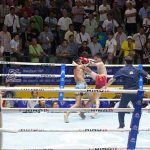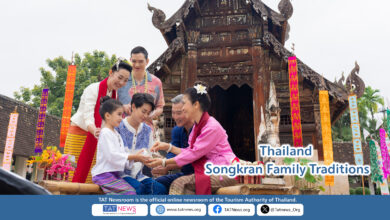Since mass-tourism to Thailand took off in the 1970s, it’s been the “thing to do” for visitors to take in a bout of Thai boxing. Even sophisticated British spy James Bond was seen ringside at the famous Rachedamnoen boxing stadium in the film The Man with the Golden Gun.
It seemed a novelty then, but these days, Muay Thai has devotees the world over and the skills of fighters like Tony Jaa, in films such as Ong Bak delight international martial arts fans. But nothing compares to seeing Muay Thai live, so most evenings, stadiums in Phuket, Samui and Pattaya are packed with tourists watching the fights.
But the best-known fight venue for true devotees of the sport has always been Lumpinee Stadium on Bangkok’s Rama IV road. Opened in 1956, the legendary venue saw the rise of many great names in Muay Thai and to be a Lumpinee champion remains the dream of all young Muay Thai fighters.
But in recent years it became clear that the old and aging stadium, though greatly loved, was not fit for purpose, and that a more modern arena with better facilities had to be built. Nevertheless, it was a sad day for Muay Thai fans when the last fight at Lumpinee took place on 7 February 2014.
Now, the new 8,000-seater stadium on Ramintra road has taken the name of its predecessor and hopes to carry on the traditions of promoting Muay Thai and entertaining spectators with exciting displays of athletic pugilism. The stadium seems a long way from the old Lumpinee in both distance and design. It’s a gleaming white, space-age building with exterior video screens showing the action inside, with none of the huge posters of fighters that adorned the old stadium’s façade.
Upon arrival, it’s tempting to go for the more expensive ringside seats, where you’ll certainly get a better view of the action. But if you are looking to immerse yourself truly in the Muay Thai experience, the cheaper seats on the third tier are the best. Here you can see the ring, and the action taking place in the crowd, which is fascinating. The third tier is home to the real fans and even in this brand new stadium, the regulars have their favourite place to stand.
As the boxers exchange skillful blows and kicks in the ring, these fans exchange fight tips and leap to their feet when their favoured fighter seems to get the upper hand. The first fights of the evening are between younger, less experienced boxers with the main fight taking place around 9 p.m. This is when the excitement reaches its peak with the crowd leaping to their feet and yelling admonitions and praise at the pugilists. It’s loud too, with the stadium’s acoustics amplifying every gasp, roar and cheer of the crowd when a fighter makes contact with his feet or fists.
Above the noise of the crowd, you’ll always hear the arena’s musicians playing Javanese clarinet, drums and cymbals – and as the intensity of the action increases, so does the tempo of the music. Music and Muay Thai are inextricably linked and here the musicians add an ancient ambience to this brand new stadium.
There’s a lot going on, but if you do some research into the rules and traditions of Thai boxing, you’ll get more out of the experience. So here’s a run-down:
Fights are fought in five three-minute rounds. A knockout means a win, but this is rare so points are counted, with three ringside judges deciding who wins each round. Points are awarded for striking opponents with knees, elbows, fists, and feet with a dazzling array of feints, grapples and dodges.
Before the fight, look out for the way fighters pay respects to their teachers in a Wai Kruu dance. During the dance each boxer wears a mongkhol or headband, blessed by a monk or teacher for luck. This is an important spiritual object and removed by the boxer’s trainer before the fight.
The new Lumpini is a great venue with clear sightlines and screens that offer a close up of the action. Outside are cafes where you snack and drink and also planned is a museum telling the history of Muay Thai and a training school where people can learn the skills of this ancient martial art for themselves.
Everyone hopes that the new Lumpinee stadium will become as legendary as the old. It’s currently so pristine you can smell the fresh paint, but character will surely develop as Lumpinee ages and new fighters become big names.
For Muay Thai fans, Lumpineei offers a state-of-the-art new venue to follow their passion, for fighters there is the chance to win glory and bring wealth to their families, while tourists get the chance to experience a unique and ancient part of Thai culture. So it’s a knock-out all-round.
Getting there
The new Lumpinee Boxing Stadium can be reached by taking the BTS Skytrain to Mor Chit station or the MRT Subway to Phahonyothin station before taking a taxi to Lumpinee Boxing Stadium. This is the time of rush-hour traffic so set out early. For more information, visit www.muaythailumpinee.net.
Tickets
Ringside tickets cost 2000 Baht while those in the back are 1,000 Baht.
Tips
- The new stadium is gets distinctly chilly so taking a jacket is advised.
- There are around nine fights per each evening starting around 18.00 hrs. The main bout of the evening takes place around 21.00 hrs.
- Women sitting in the ringside seats should not touch the ring itself as this is seen as a sign of bad luck for the fighters










